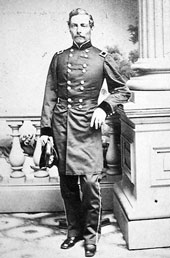 General Pierre Gustave Toutant Beauregard
General Pierre Gustave Toutant Beauregard
 General Pierre Gustave Toutant Beauregard
General Pierre Gustave Toutant Beauregard
Background


|
Birth: 28 May 1818, St. Bernard Parish, Louisiana
Death: 20 Feb 1893, New Orleans, Orleans Parish, Louisiana
Buried: Metairie Cemetery , Metairie, Orleans Parish, Louisiana
Biography: Beauregard was born a member of a prominent Louisiana family, and graduated second in his class in 1838 from West Point. Following his graduation, Beauregard was commissioned a second lieutenant in the Corps of Engineers, and assigned to Fort Adams, outside Newport Rhode Island. In June of 1839 he was promoted to lieutenant and transferred to Pensacola, Florida, where he was placed in charge of constructing coastal defenses. At the start of the Mexican War, he served as a staff officer with Winfield Scott in the Mexican War and was wounded twice in action during the fighting around Mexico City. After this war, he continued overseeing the construction of fortifications on the coast. He became superintendent of the U.S. Military Academy at West Point on 23 January 1861, but resigned that position 5 days later (the shortest period of time any man has held this post) to accept that of the first Brigadier General in the Confederate Army. As such, he commanded the Confederate forces in Charleston and ordered the attack on Fort Sumter. He designed the Confederate battle flag in September, 1861, and led the Confederate forces at the First Battle of Manassas. Reinforced by Joe Johnston’s army the day before 1st Bull Run, he exercised tactical command on the field, being more familiar with the ground. Following Rebel victory on the field, he was named full general from the date of the battle, but fell out with President Davis over the aftermath of the battle. Beauregard claimed that had Davis not prevented him, he could have taken Washington on the strength of his victory. In April 1862, he was sent west where he assumed command of the Army of the Tennessee at Shiloh after General Albert Sidney Johnston was killed. Confederate troops under Beauregard fell back to Corinth, Mississippi, but abandoned the city to Federal General Halleck's larger force. Illness forced his temporary retirement, lasting just 2 months. As commander of the forces holding Charleston after 1862, he successfully prevented capture of that city by Federal forces until near the end of the war. He was sent north to take command in North Carolina and southern Virginia while Lee faced Grant’s forces north of Richmond. There he managed to bottle up Ben Butler’s Federal Army of the James in the Bermuda Hundred after defeating him at Drewery’s Bluff. Beauregard also managed to thwart the Union attempt to seize Petersburg when Grant slipped away from Lee and shifted his army to the South side of the James in an effort to cut the supply lines into Richmond. He continued to serve under Lee during the siege of Petersburg until September of 1864 when he was shifted once again, this time assuming overall command of the West. With no troops under his immediate command he was unable to contest Sherman’s celebrated March to the Sea. During the final days of the war he was second in command to Joseph Johnston in North Carolina. After the Confederate surrender, he returned to Louisiana, became president of the New Orleans, Jackson, and Mississippi Railroad, managed the Louisiana state lottery, defended his military reputation, and was a well-known military historian of Civil War battles.

|
Source:
Confederate Military History, Volume I
Columbia Military Prison Page
 or to Seed Corn Page
or to Seed Corn Page

 If you have any information about him or the units he commanded, please contact
me at
If you have any information about him or the units he commanded, please contact
me at
 Bil Brasington
Bil Brasington